Tagged: ContentMarketing
How to Plan & Run a Successful Crowdfunding Campaign (part three)
- by Alyson Shane
Welcome back to the third instalment of the Crowdfunding Crash Course series!
This series of summary posts is designed to go over the lessons learned through more than a dozen interviews with crowdfunders during the course of this project, all with a little bit of insight from myself (of course.)
This instalment will focus on a few things to do after your campaign ends, so let's begin!
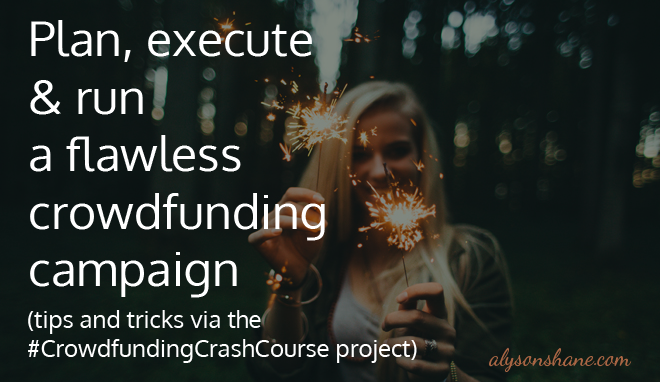
Thank Your Backers - No Matter What the Outcome
If your campaign succeeded, congratulations! You kicked some ass, took names, and raised your funding goal. At this point it's crucial to reach out to all of your backers at every level and thank them for contributing to your project and supporting you in your endeavours.
However, if your project was unsuccessful reach out anyway. Be honest with your backers. If you used Indiegogo or a service which allows you to keep the funds you raised, let them know how you plan to spend the money. If you used a service like Kickstarter and you know they'll be getting a refund, reach out and thank them sincerely. If you can, let them know what your next steps are and how they can continue to follow and support your project beyond the campaign.
Remove a Failed Kickstarter Campaign Before It Ends
If you're using Kickstarter and you know a few days before your campaign end date that you're not going to meet your funding goals, shutter your campaign and regroup before it ends. Otherwise you'll be left with a dead, unfinished campaign that will sit on Kickstarter indefinitely.
This was one of the things that Meghan Athavale mentioned in her interview. She said that initially she tried to raise funds using Kickstarter, but didn't plan enough and unfortunately the first time around her team didn't meet their funding goals.
However, what she didn't realize was that she couldn't remove her failed campaign after it ended, which means that when she re-launched an Indiegogo campaign, even though she was significantly more prepared and met her funding goals this time, she still had an old, failed ghost of a campaign out in the ether of the internet. If you think that this is something that could cause issues for you in the future, cut your losses and end your campaign while you still have the chance.
Map It Out!
The overarching theme of this project seems to be plan as much as humanly possible (have you noticed?)
Do-to lists, checklists, all those tools come in handy when planning a campaign of any sort, but the old classic tool is still one of the best: a calendar with all of your important dates, milestones, and reminders plugged into it.
If you're a bit old school like me you might like to physically write things down when you plan, but if you'd like to keep things digital (way easier when working with a team) Indiegogo has a fabulous calendar tool which you can use to plan your campaign well in advance and make sure you don't miss any important dates or milestones.
It's also pretty helpful if you're new to this whole experience and are unsure of when you should be planning each step. Personally I think the timelines are a bit aggressive -I'd give myself a few months to adequately plan, instead of just a few weeks- but that's entirely up to you and how prepared you are!
Learn the Tools of the Trade
This factors into what we talked about in the 2nd recap post, where we discussed the importance of having a game plan to promote your campaign and manage it before you start. Doing your research into the best platforms and tools to help you craft, create, and distribute your message to the masses can make or break your campaign.
Below are a few great resources to get you started:
Video Creation & Editing: iMovie or Stupeflix
Video Hosting: Vimeo or YouTube
Landing Pages: Unbounce
Social Media Management: Hootsuite, Buffer, Crowdbooster, SocialFlow, Sprout Social
Link Shortening: Bit.ly, Snip.ly
Want even more?
I'm thrilled to announce that I'm in the process of putting together The Crowdfunding Crash Course eBook!
As I was putting together this post I found myself having to go back through posts and interviews I'd written, and sift through them to find the information I wanted. It was clunky, confusing at times, and not at all the kind of succinct, awesome experience that I want to provide for all of you.
So, with a very limited knowledge of iBooks Author, I set out on a quest to put together the most complete version of the Crowdfunding Crash Course project to date, all compiled in a handy little book for you to reference and use whenever you need!
The eBook is full of tips, tricks, breakdowns and, of course, the interviews from the Crowdfunding Crash Course Project. In addition to the information already available in post format, I'll be providing a more detailed breakdown and analysis of each campaign, as well as additional insights and advice to prepare for, and manage your campaign after it's ended.
The Crowdfunding Crash Course eBook will be available for free to all of my newsletter subscribers, make sure you sign up to get your hot little hands on one of the first copies!
I'm so excited to be sharing this news with you, and can't wait to get The Crowdfunding Crash Course eBook out there into the big, wide world!
xox
Alyson
How to Plan & Run a Successful Crowdfunding Campaign (part two)
- by Alyson Shane
Welcome back to the second instalment of the Crowdfunding Crash Course recap series!
In this series we'll be covering the lessons that the participants of the Crowdfunding Crash Course project shared with us, all summed up in a few handy posts (with some input from yours truly, of course.)
If you think you have an amazing idea that you have to share with the world, it might seem like crowdfunding is the easiest way to get your message out to a lot of people. Spoiler alert: it isn't. A successful crowdfunding campaign is rarely one that you can "set and forget" and takes about as much planning and preparation as a run-of-the-mill marketing campaign.
Honestly though, I didn't fully grasp any of this until I started this project. This is because a good crowdfunding campaign, like most things that are done well, looks pretty effortless.
This realization is why I decided to start doing recap posts - to help dispel some myths about the process, and to break down the steps to take to make sure that your campaign is every bit as successful as it can be!

Do Your Research
Luckily for us, neither Kickstarter nor Indiegogo, the two most popular crowdfunding platforms, automatically remove campaigns once they've ended. This is great news for you, a budding crowdfunder, because it means that there's a wide variety of projects to explore and research. If you're lucky, there may even be a few similar to what you're planning to do, which can be great opportunities for some research.
For example, if you're planning a crowdfunding campaign to raise money for your nonprofit which will develop a product to be used in developing countries, you'd be doing yourself a disservice if you didn't take a look at the SolarPuff Kickstarter campaign page, and that's just one that we know about! A quick search for "nonprofits" will bring up a variety of campaigns for you to draw inspiration from.
The best part about the fact that all those older campaigns are still out there is that it gives you an idea as to how different campaigns managed to meet their funding goals... or if they didn't.
Some things to check for are:
- The quality and length of of the video
- Message and story
- The strength of the pitch (or the "ask")
- The kinds of perks offered at the start
- If any perks were added any later into the campaign
- If the campaign met it's funding goals (or if it didn't, how close it came)
Crowdfunding, as an industry, is unusually transparent because everything is out there in the open for all to see. Campaigns, by their nature, are public, and the information is there for you to learn from. All you have to do is take the time to do your research!

Pick the Best Platform to Suit You
The two major crowdfunding platforms out there are Kickstarter and Indiegogo, and because the interviews I did for this project happened to all be on either platform, these are the two we'll focus on right now.
Kickstarter is an "all or nothing platform" which means that if you set your crowdfunding goal as $100,00.00 and you only manage to raise $95,000.00, you don't get to keep any of it. In fact, when someone donates to your campaign their credit card isn't charged until your campaign reaches it's goal.
Indiegogo has what's called a "flexible funding system," which means that as backers donate to the campaign, the organizers get that money in real time. It also means that they get to keep the money that's been backed so far, regardless of whether or not you reach your goals. Indiegogo also allows you extend the life of your campaign, and change your funding goals halfway through your campaign.
Kickstarter dwarfs Indiegogo in a few key ways: it attracts more traffic, it features a "Projects We Love" newsletter and feature area on their site which can propel a floundering project well past it's target goal, and it attracts more pledges, and pledges in higher amounts.
However, Indiegogo has it's strengths: it's had almost 100,000 more successfully completed campaigns than Kickstarter; this is because when a campaign is about to expire and hasn't reached it's funding goal, many people pull them from Kickstarter before the end-date.
Ultimately the platform you choose is up to you! Do your research and invest your time in the platform that you think will do the following:
- Allow you to provide the kinds of rewards you'd like
- Has funding options that you're comfortable with
- Provides you with ways to promote your campaign
Work With a Team
One of the striking things about the interviews I did for this project was the sheer amount of man-power that goes into planning, executing, and managing a crowdfunding campaign.
Running a campaign takes a lot of time and effort. You have to plan before your launch, manage the marketing leading up to and during the campaign, communicate with funders, answer questions, and any variety of things that might pop up or be unique to your project.
According to Indiegogo, crowdfunders who worked with teams of three or more raised over three times as many funds as campaigners who chose to go at it alone. This is likely because having more people on your team means you have an extended network of people to share it with, and potential funders!
It never hurts to have each member of your team promoting your campaign on their own individual social media feeds, and to their friends and family; even more incentive to surround yourself with a great team of people to help your campaign be a success!
Communicate Consistently
Nothing makes a backer feel like they wasted their money more than a campaign that goes dark the moment you donate. Besides that, you don't want people to forget about your campaign the second they give you money, do you? Of course not, which is why communicating is so, so important.
One of the most effective things you can do to keep things fresh is to keep updating your campaign page after you launch. This is essential! Regardless of the type of project you're trying to fund, you want to keep your backers in the loop every step away (this plays into what i was saying earlier about crowdfunding being an extremely "transparent" industry).
This means updating your page when you've hit important milestones, have press mentions, or new perks that you've added after the campaign launch (more on that in the next instalment, I promise!).
Updates to your campaign will automatically be emailed to anyone who contributes, making this step a total breeze and the easiest way to communicate with your backers post-launch. It also helps your backers know that you appreciate them and their efforts in helping you succeed.

On average, most crowdfunding campaigns post at least four updates over the course of their campaign, and these posts could cover a wide variety of topics, such as:
- Important funding milestones (30%, 50%, etc)
- New perks and incentives
- Profiles of that terrific team you've put together
- Behind-the-scenes looks at your process, product development, etc
- Press coverage
- and more!
Staying in touch with your backers is key, and can often help put you over the top of your funding goals during those final, stressful days of your campaign. If you send an update to your backers which reads "only $200 to go until we've met our goal!" and that backer is emotionally (and financially, now) invested in seeing your campaign succeed, they're much more likely to forward the email to others and ask friends to donate to that awesome, super-cool campaign, too!
Is That It?
Heck no! There's still more to cover, so make sure you check back to the final instalment of the Crowdfunding Crash Course Recap Series
This post is part of a series. For all of the Crowdfunding Crash Course interviews and summary posts, visit the Projects section of my site!
Simple Steps to Build Your Personal Brand
- by Alyson Shane
If you're anything like me, you spend an egregious amount of time online chatting, sharing comments, articles and opinions, and connecting with other people.
If you don't, or if you're just starting to, then you may not be familiar with the concept of personal branding, and how it can help you achieve your personal and business goals.
What Is Personal Branding?
Your personal brand is how people in your community and the world at large think about you. It's the sum-total of all of your activity online, which helps paint a picture of who you are to the people who know you through online social channels like Facebook, Twitter, LinkedIn, Pinterest (to name a few), and your website, if you've got one.
Having an understanding of personal branding is a powerful tool because it allows you to actively shape how people see you, and gives a focus and direction of the tone, quality, and direction of the content you share.
In this post we're going to cover a few simple ways that you can build a strong personal brand which not only reflects the fabulous person that you are, but also how it can help you achieve your goals!
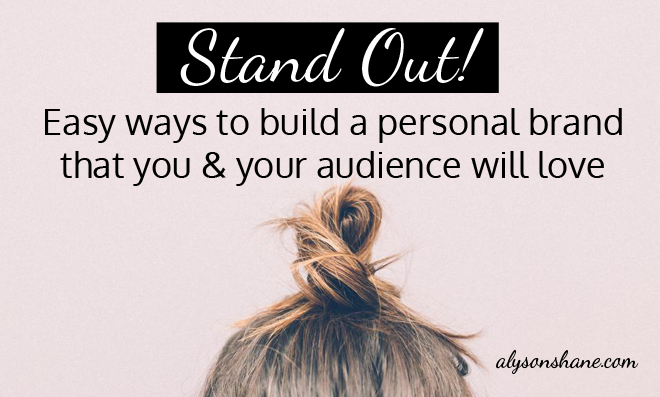
Build a Website That Reflects Who You Are
I'd argue that the most important piece of the puzzle regarding your personal brand is having a website that you love. Something sleek, cool, easy-to-navigate and which accurately represents who you are to the world.
Your website should have an active blog, and should act as the hub for all of your activity online, with your social media feeds regularly linking back to it. Blogging not only helps with SEO (search engine optimization) which is how people find your website, but also helps people gain a better understanding of who you are through what you write and share.
Back in the day people (like me) wrote lifestyle blogs, which were basically like online journals and didn't really exist to serve a purpose other than somewhere for us to publish our thoughts. These days, though lifestyle blogs still exist, they aren't as frequent, and blogging has taken on a more professional quality.
If you're a professional, blogging regularly about events in your industry and sharing ideas and opinions is a great way to help your audience understand who you are. Though I'd argue that lifestyle blogging even has a place, too! While blogging about your industry is great, people still want to see who you are, which is why sharing posts about things you've done, events you've attended, or experiences that you've had are also valuable content.
Explore & Be Your Authentic Self
I write about authenticity a lot, and one of the reasons that I keep coming back to it is because who you are and how you craft your personal brand can make or break your future prospects. if people think you suck, they won't want to work with you.
Luckily being your authentic self is easy: you just have to be who you are.
I've read suggestions on other blogs and websites that suggest trying to craft a "fake" version of yourself; someone who reacts to things differently than you normally would, and makes statements that contradict how you actually feel about an issue. I totally disagree with these suggestions.
Personal branding is about nurturing the best parts of ourselves, being honest and vulnerable, and sharing those parts of ourselves with the world. We're all flawed human beings who are in a constant state of growth, and part of crafting a personal brand is being open about who we are, in as much (or as little) detail as we're comfortable sharing.
Some key things that your personal brand helps people understand are:
- What do you believe?
- What are your goals and ambitions?
- What are your strengths and weaknesses?
- What kind of client/contractor/employee/business owner are you?
- On a scale of 1-10, how much do you love inspirational sloths?

(okay, that last one was just me)
Remember: people connect with other people. Being authentic builds trust.
If you don't appear to be a real human being, or seem like you're faking your way through everything (aka being full of shit) how will people trust you it they don't feel like they know the real you?
One last thing:
Being your authentic self also means that you'll rub people the wrong way. There's always going to be someone out there, naysaying whatever you blog about, share, or reflect on publicly. That's okay. To quote the ever-wise Taylor Swift "the haters gonna hate, hate, hate, hate, hate."
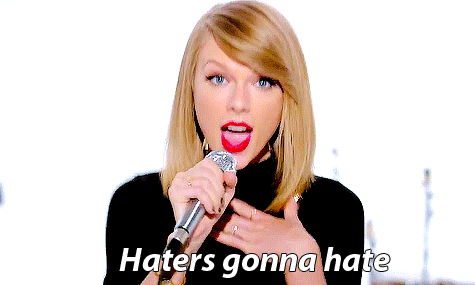
Get Speaking
One of the easiest ways to build up your personal brand is to speak publicly about what you do. Whether it's at a conference, a local meetup, or to a classroom full of students, speaking about what you do not only builds awareness of you and your personal brand, but (bonus!) it'll help you be better at what you do.
If you're not used to speaking it can be really daunting, but a bit of practice and some great reference material (I like to make my own slides using Keynote) you'll have a whip-smart presentation in no time. Additionally, having to break down complex ideas, concepts, or speak about your strategy or workflow can be immensely helpful in helping you develop clearer way to communicate it to everyone else.
Case in point: last April I spoke about the importance of social media at the Manitoba Trucking Association's Driving the Future conference. While I discuss social media with my peers and clients on a regular basis, having to explain things like Twitter to a non-user helped me develop a better understanding of how to convey important ideas. That presentation is what led me to develop my Twitter for Beginners series. How cool!
When you speak do so from a place of knowledge and power and show that you know what you're talking about. Speaking engagements not only help people understand what you do and who you are, but they're also terrific confidence-builders, too. Win/win!
Write About What You Do & Participate in Interviews
Thought leadership articles (like the one you're reading) which provide advice, insight and reflection into what you do help give you major cred. Thought leadership articles not only give you the opportunity to discuss what you do from the comfort of your own keyboard, but can also provide valuable research and learning opportunities as you fact-check and find references to back yourself up, as well (cha-ching!)
I'm a big proponent of knowledge sharing, and I believe that it's single best way to make people aware of what I do. Not just that, but it helps people, too! How awesome is that?
Regularly writing authentic, helpful content is one of the best tools at your disposal to help build awareness of your personal brand, and establish trust between yourself and your audience.
Bonus points:
The more content you share, the more likely it becomes that people will reach out to you for interviews, commentary, advice, collaborative opportunities, and work!
Maintain Your Online Presence
If you don't have social media profiles, now is the time to start setting them up! While publishing thoughtful content on your website is great, you need to have an active presence on relevant social media sites in order to share your content and push people back to the 'hub' of your personal brand (aka your website.)
Here are some questions to ask yourself when going over your social media profiles:
- Do they all contain relevant information?
- Do they link back to your website?
- Are you presenting yourself in the best way possible?*
- Are you using high-quality photos?
- Are you interacting with others and sharing their content in addition to your own?
* What I mean is this: no ranting, no sub-tweeting/vaguebooking, no snarky comments, no racist/prejudiced/inflammatory remarks. While jokes, comments and etc may be okay in person and around specific friends, this type of behaviour is something that you should actively avoid doing whenever possible. It just looks bad, m'kay?

Never Stop Learning
This applies no matter what industry you're in. The world is changing quickly, and we all have a responsibility to stay as informed and up-to-date on the latest changes and trends in our respective industries.
Building a strong personal brand takes time, and if you don't stay relevant then you'll fall by the wayside and all of that time you spent building it up will be for nothing. I regularly hit up sites like Hacker News and Social Media Examiner to stay informed of goings-on in my industry - I'd be lost without them!
Bonus: sharing about what you've learned, or writing a blog post about a topic you've been reading about it a great way to create some original content. Remember: people are coming to your website because they want to hear your thoughts; they could easily go anywhere else, but they came to you. Make sure you're rewarding your audience with well-researched and current opinions and facts.
The more time you spend working on and crafting your personal brand, the stronger your image will be and the sooner opportunities will start coming your way based on people's perceptions of you. Your audience will see you as a sincere, intelligent person and will be breaking down the door to work with you.
Did I miss anything, or do you have something to add to this post? If so, leave a comment,shoot me an email, or tweet at me on Twitter!
5 Essential Content Marketing Habits
- by Alyson Shane
Content marketing is one of the move valuable tools at your disposal to add value to your marketing strategy. Good content educates your audience, prospects potential clients, and when done correctly does a powerful job of advertising your brand message.
However, if you're managing multiple accounts at once and want to stay as organized and focused as possible, it's necessary to start developing the right habits as early as possible. Below are a few key things that I've learned which have helped me save my sanity, and be better at what I do.
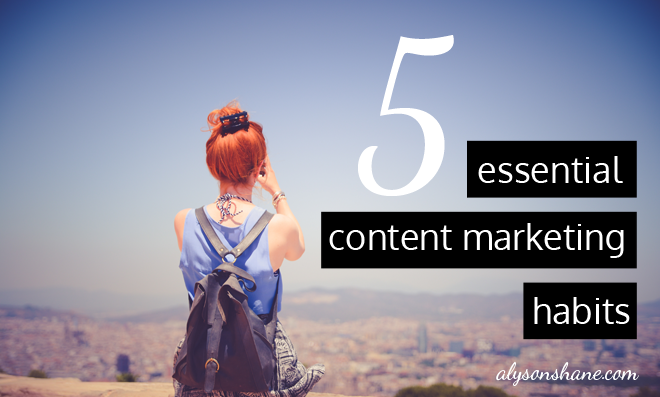
1. Track Your To-Dos
I've mentioned my daily checklist in a previous post, but having a concrete, written plan for what you need to do each day/week/month/etc is unbelievably helpful. This is especially true when you're working on a project which requires a team effort, and a bit of project management.
My favourite tool for this purpose is Trello because it's super-easy to learn to use, has a simple design based on columns and checklists, and allows you to drag specific tasks "bubbles" around between columns, so everyone can see where you are on a specific project.
Here's an example via a quick Google Image search to give you an idea of what it looks like:
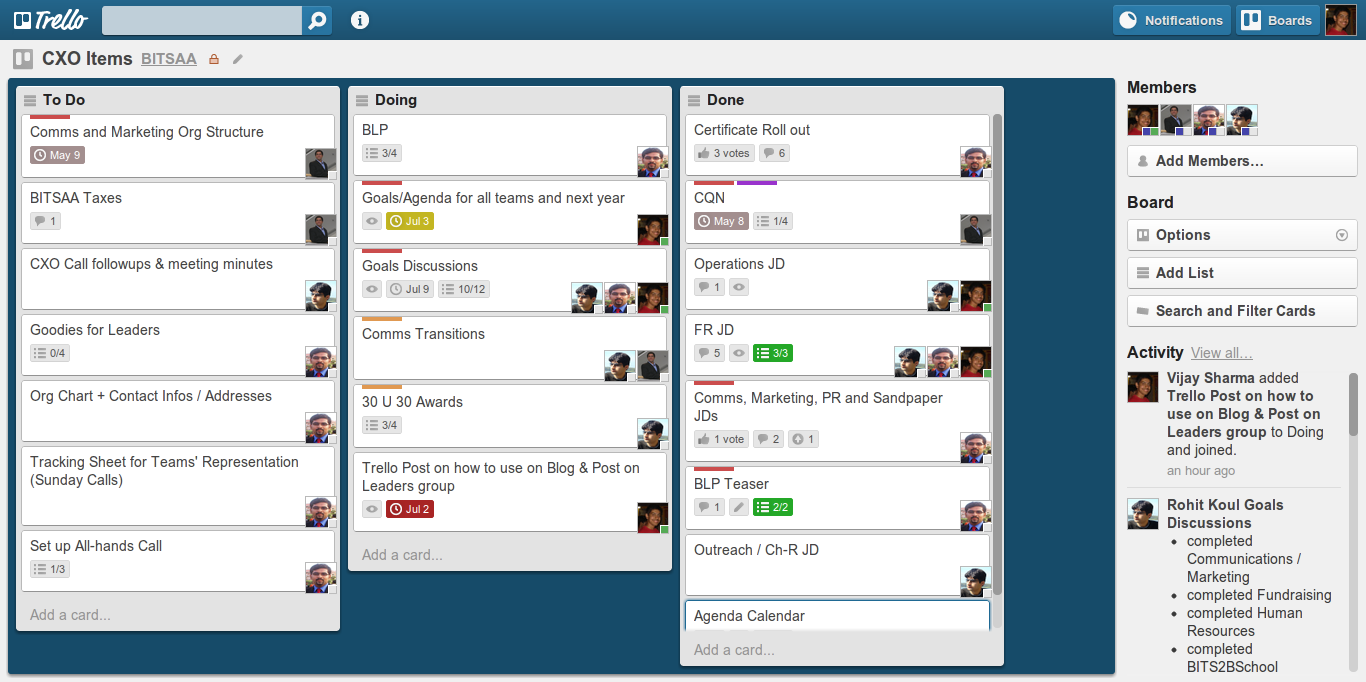
Having tools like Trello (or Asana, or Slack, whatever your preference) helps with communication in teams who may not be in the same office, or even the same country, and allows you to easily keep track of who is working on which portion of the project, and where they're at. Being able to access this stuff at-a-glance is super easy, and saves a ton of time.
2. Establish Milestone and Conversion Goals
Before you sit down and start tweeting or posting, establish what your definition of "successful" looks like. Is it 2,000 newsletter subscribers by Thanksgiving? To speak at a nationwide conference next year? Maybe hit a million visitors to your website this month?
Whatever the case, by developing a clear vision of success and what it looks like not only helps you plan how you will achieve those goals, but also helps you have a clear game plan which can be adapted to deal with any unexpected changes.
Conversions are the best way to measure the success of your campaign (think bread-crumb trail) and anything that you do which leads a user down your breadcrumb trail is worth tracking.
3. Analyze Behaviours and Achievements
Behaviours are the actions that visitors take once they arrive at your website, and achievements are when they behave based on the breadcrumbs that you left for them to follow.
By keeping track of how people move through your (or a client's) website, you can gain valuable information as to how people are getting there, and how they're moving around. Ideally, they'll follow a set of pre-defined steps that you've put in place in order to get them to visit a particular page, or buy a product.
So whenever you identify a new measurable behaviour (maybe your traffic goes up, your website's ranking increases, your click-through rate increases, etc) you can analyze the behaviours that led to the increase, and refine and revise when necessary to make sure things keep going well.
4. Get In the Cloud
This took me longer to get into the habit of doing than I'd like to admit, but saving all your documents, contracts, photos, and work in the cloud (I use Google Drive) is the only way to be truly effective wherever you are, and saves a ton of headache down the road.
Here's an example: I invoiced a client before I went out of town, but they sent me an email a few days later and said that they needed me to re-submit it. So instead of having to worry about re-creating an invoice from scratch because my original document was on my iMac back in Winnipeg, I opened the Google Drive app on my phone, found the invoice (I also have all of my invoice templates saved there, just in case) and re-shared it within the span of a few minutes.
It saved me a ton of time time and and I was able to avoid the headache and stress of re-creating an invoice to make sure I got paid when I was expecting to.
There is literally no excuse for you to not be using a cloud-based sharing service, so get on it!
5. Report & Tweak
Though many people are starting to see the value of of it, a lot of people still view content marketing and social media as a wishy-washy thing to spend money on, so us content marketers need to be able to prove our worth.
The best way to show value is through reporting - showing successes, areas of improvement, engagement levels, and providing recommendations on how to move forward. It also helps with long-term planning, as reports can indicate shifts in behaviour and engagement over time, which allows you to identify things that succeeded, and things that didn't.
Reporting can be (okay, almost always is) a chore. It's boring, but by taking the time to put together a comprehensive report you can effectively demonstrate your value, as well as open up lines of communication with your clients. Reporting builds trust and helps clients feel like they've got a good grasp of what's happening, even if they're totally hands-off day-to-day.
Developing the right habits from the get-go allows you to not only feel more organized, but it actually makes you better at your job, which is good news for both you and your clients.
Did I miss anything from this list? Do you have anything you'd like to add? If so, leave a comment, shoot me an email, or tweet at me on Twitter!
The Guide to Creating Killer Content
- by Alyson Shane

Once upon a time, back in the old days of 1996 Bill Gates wrote an article called Content is King. In it, he talks about the future of the internet, and how this new and exciting medium can be used to distribute information worldwide at basically zero cost. He also discussed how content isn't one single idea or thought, but rather the sum-total of everything that we share online, which can include ideas, products, and experiences.
Bill Gates is clearly a clever guy (duh) and his article is still as relevant today as it was when I first read it in Computer Science class. Nowadays, however, we have a multitude of ways and means to create and share content under the guise of your brand, professional or personal.
This can be anything including:
- Your website
- Blog posts
- Original images, photos and infographics
- Your profile photos across social networks
- Social media profiles including:
- Tweets on Twitter
- Facebook status updates
- Instagram photos
- Youtube or Vimeo videos
- Pinterest pins
- Google+ content
- LinkedIn updates
- Newsletter emails
- Emails you send to clients and colleagues
- Handouts, checklists, ebooks and resources you've created
- Other stuff of this nature (you get the drift)
The sum total of all of this stuff is how people will perceive you online, so your content really matters. People will click around to your Twitter, LinkedIn, Pinterest, website, and anywhere else you hang out online to try and suss out who you are and what they think of you.
The kind of content you share determines your value to other people, so today we're going to go through a few quick & dirty questions that you can ask yourself to make sure that you're creating and sharing the best possible content that helps people see who you really are, and adds value to your brand.
Does your content help others?
One of the biggest takeaways for me from the #SocialHour Twitter chat last week was that everyone indicated that they considered quality content to be helpful and informative. People are looking for posts, articles, and images that give them information and help them solve problems that can't be easily Googled.
This means that some of the best content you can create is the kind that answers questions, presents solutions to problems, and is otherwise generally helpful.
Here are some questions you can ask to determine some helpful content you can create:
- What kind of content do you like to read?
- What kind of content does your audience like?
- Hint: check stuff like your Twitter analytics to see what sorts of shared content resonate with your audience
- What sort of content are other businesses in your field sharing?
- What kinds of questions are being asked in blog comments, Twitter chats, etc that you can answer for my audience?
- What sorts of topics interest you, and would be fun to explore and learn in order to share?
- Can you turn any of these content ideas into long-term projects, video tutorials, printables, white papers, and other resources your audience can use?

Are you authentic?
Aka, does the way that you're presenting content online jive with who you are in real-life?
We all try to put forward the best versions of ourselves online - that's normal, don't worry about that pressure (we all feel it) - but when it comes to our content we can share heaps of information, articles, and posts without actually saying anything about who we are if we're afraid to do so.
However, the more 'real' we can be online, the more people will gravitate to us and hear what we want to say. This is because people (read: your audience and potential future clients) aren't just coming to you because you have encyclopedic knowledge of Google Analytics, or you knit the best cat sweaters. They're coming to you because the like who you are, and part of helping people get to know the real you is by sharing parts of your life with them.
Here are a few ways you can help people get to know you:
- Share funny or interesting photos of your life
- Include relevant stories in blog posts and status updates
- If you're feeling brave, share a recent struggle and what you've learned from it
- Share what you know (check out The Case for Knowledge Sharing for more on that topic)
Additionally - and I've said this before - make an honest and concerted effort to be positive online. Part of being authentic is sharing your struggles, challenges, and learning experiences, but don't actively badmouth, vaguebook, subtweet, or write passive-aggressive posts or emails about other businesses or people. We all have catty moments (we're human, after all) but you never know when it will come back to bite you.
Is your content entertaining?
#RealTalk time: you could be providing the best, most helpful content on the planet but if your posts read like cardboard and you sound like a Speak 'n Spell on video, nobody's going to want to take the time to hear what you have to say.
Here's an example: When I was in high school I had an amazing teacher named Mr. Kenny. He was so freakin' weird, you guys. He only cut his hair once a year for his wedding anniversary, wore a red nylon strap as a belt (the kind backpacks come with), and had less than a dozen tshirts, all of which he got for free and one of which said Is that your final antler? on it. He had the weirdest stories (like punching a kangaroo) and was always incredibly entertaining.
Mr. Kenny taught science (which I was embarrassingly bad at) and his students generally did really well because he was into what he was always super excited about what he was teaching, and he was such a character that he didn't have to work very hard to keep our attention.
Nowadays when I'm writing, or sharing things online, I try to channel Mr. Kenny's weirdness because I know that keeping people entertained is what keeps them coming back. It's not just about sharing information, it's about doing so in a way that keeps people interested and entertained.
How can you be more like Mr. Kenny? Ask your self some of these questions:
- What sorts of personal stories can you use to make your content more relatable?
- Can you work sarcasm and jokes into what you're writing?
- Can you find relevant interesting or funny photos, gifs, and videos to complement up your content?
- Would your audience appreciate seeing your goofy side?
Your turn!
Here are a few questions to get your brain waters going:
- What kind of content can you create this week that will benefit your brand?
- What fun, personal thing happened to you today that I can share with your audience?
- What are five topics I can write about this month that will benefit my audience?
Stumped for ideas? Leave a comment and let's chat about it!
Twitter for Beginners (Extra Credit): Delving deeper into Twitter Analytics
- by Alyson Shane
Since I wrapped up my Twitter for Beginners series I've had a handful of people email or or @mention me asking questions about Twitter Analytics.
We discussed the importance of analytics a bit in Part 3, but I thought that since it's come up a few times since, we could do a little 'extra credit' session and share a little more in-depth insight into how to read your analytics and make the most of the data!
What you're looking at
Before we delve too much into this post, let's take a second to go over some of the phrases we'll be discussing, and what they actually mean.
- Engagement: The total number of times someone interacted with your tweet (more on this in a few moments)
- Engagement rate: Number of engagements divided by impressions
- Impressions: Times someone saw your tweet in their timeline or search results
- Link clicks: Clicks on a URL or Card in the tweet
- Permalink clicks: Clicks on the tweet permalink
- User profile clicks: Clicks on your name, @handle, or profile photo
- Detail expands: Clicks on the tweet to view more details
- Embedded media clicks: Clicks to view a photo or video in the tweet
- Follows: Whenever you gained a new follower as the result of a tweet
Got it? Good. Let's go!
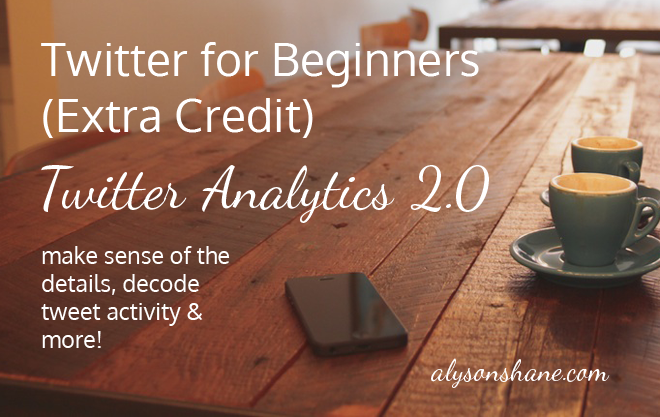
Get monthly reports
If you check out your account home you can see a quick overview of your Twitter stats. This page shows stuff like monthly average engagement rates, replies, profile visits, etc.
This is pretty standard stuff, but can be really helpful at-a-glance and is great when you need to reference something in a meeting (I do this with my clients often.) It's especially helpful because Twitter will calculate the percentage of increased or decreased engagement, so you can start to dig into why a particular set of tweets earned more impressions, or not.
If you want a more detailed explanation you can check out the Tweets page which shows you much more in-depth metrics. Clicking on a tweet will show you engagement broken down further into ReTweets, Favourites, Clicks on Media, Link Clicks and more.
Measure engagement
One of my favourite features on the home page is the 'Engagements' section on the right-hand side, which breaks down your engagement rate into easy-to-read graphs, percentage points, and an 'on average' recap which gives you a basic idea of how your tweets are performing each day on average.
What does engagement measure? Tons of stuff! Such as:
- ReTweets
- Replies
- Follows
- Favorites
- Links
- Cards
- Hashtags
- Embedded media clicks
- Username clicks
- Profile photo clicks
- Tweet expansions
This is, in my experience, the easiest way to pull pertinent information from Twitter. I use it whenever I'm putting together a report for a client, or when I want to see how I'm doing - once you're used to looking at it I'm sure you'll be just as obsessed with it as I am!
Find out who your influencers are
When you're on the Home page you can get insight into who your top followers are every month in terms of reach, as well as whose @mention to you created the most engagement. You can also look at the Followers page for your Top Follower, which gives you insight into the kinds of people who are following your biggest influencer.
For example, my highest mention this week was from my hilarious pal Kieran, who tweeted this during the recent Canadian Federal Leader's Debate:
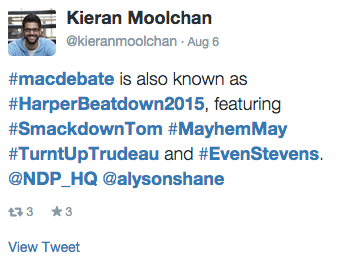
Who should you care? Understanding your top influencers helps you figure out the kinds of people who are active online (and who have active followers, themselves) and the types of people who are most actively engaging with and sharing your content. This type of information can also be helpful when trying to figure out someone to reach out to help you promote an project or collaborate together on an idea.
Get to know your community
If you're trying to grow your community in a specific direction the followers page is your new best friend! it's full of insight into people's top interests, their demographics, and how your followers have grown over time. This last bit of information is especially important if you publish original content regularly or participate in Twitter chats, because you can track what sorts of actions are the most effective at growing your community.
Here are a few key things to look for:
- Which topics your audience are most interested in
- Followers by region (ever have tweets that explode in popularity while you're asleep? This might be why)
- Which language they speak (mine's overwhelmingly English, which makes things easy)
- Who your followers follow (some competitive research never hurts)
See if your posts being re-shared or favourited
Whether or not a post gets Quoted or ReTweeted or Favourited tells a different kind of story about the tweet. Quoting and ReTweeting is generally a sign of value - someone felt that your content was valuable enough to share it with their audience, as well.
Favourites are like virtual fist-bumps: someone liked what you had to say and is giving you props by Favouriting your tweet.
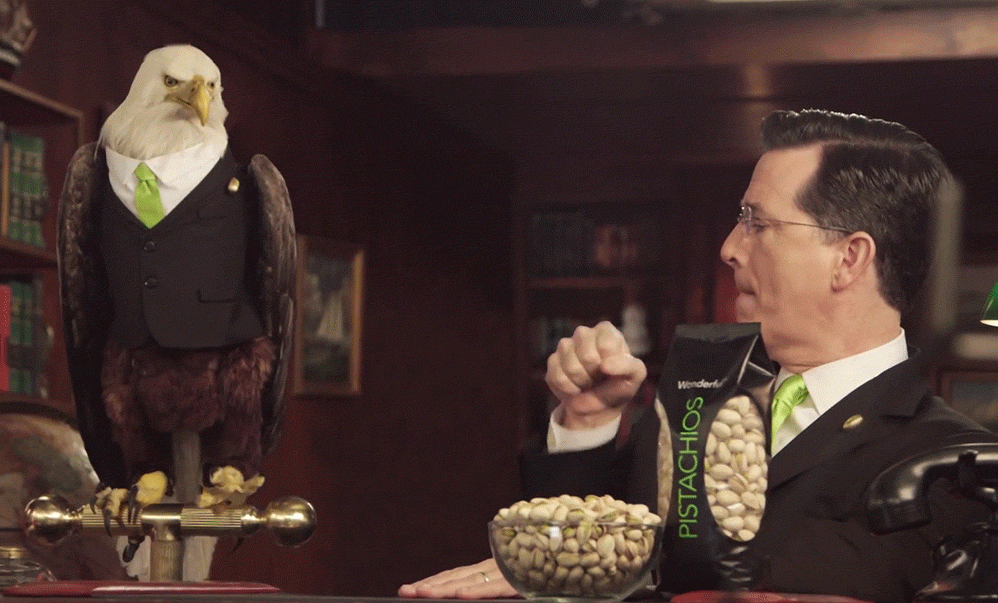
Figure out your "Favourited Rate"
I first read about the "Favourited" Rate theory over on Dave Shure of Evolving SEO's blog, and it totally changed the way that I thought about Favourites. I frequently hear people bemoan the fact that people "just favourite" a post instead of Quoting or ReTweeting it, but favourites can be just as insightful if you approach them this way:
Your followers are going to click 'favourite' for a bunch of reasons, but most likely they're expressing agreement with whatever you said in your tweet. If you track the types of posts that get the most Favourites, you can often find trends emerging which can help guide your decisions when trying to figure out the kind of content to share. This is a huge boon because your audience is directly (if not unintentionally) showing you the kind of content that they like best.
Your turn!
These are just a few of the way that Twitter Analytics can help you figure out how to make the most of your tweets and grow your audience. Go, check out what we've covered here today, and and if you'd like me to cover it drop me a line and I'll get cracking on the next Extra Credit instalment!
PS if we're not already pals on Twitter, make sure to follow me and connect with me there. I love chatting with my readers!
This post is part of the three part series on Twitter for Beginners. Make sure to read part one, part two, and part three as well! The entire series can be found here.
Twitter for Beginners Part 2: Tweeting, Discovering & Making Connections
- by Alyson Shane
Welcome back to my Twitter for Beginners series!
In the first post we discussed how Twitter works and became familiar with the terminology behind what we'll be discussing in this post, so let's get into the real nitty-gritty of starting to build a presence on a social network:
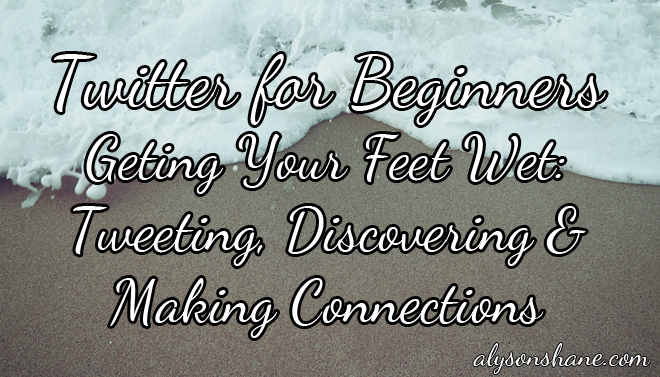
Your Account
Most people join Twitter for personal reasons: to connect with others, promote a business, make friends, etc. Some people join up and create parody accounts, which can revolve around themes or celebrities, but for most of us (and for the purpose of this series) let's just assume that you've signed up to Twitter because you're trying to connect with others and promote your business.
With these goals in mind, your profile should include a recent photo of you, as well as a short bio with links to any work or webpages that you want people to associate with your account.
Here's what my Twitter bio looks like, for example:
It's clear who I am, what I do, and gives potential followers an idea as to what they can expect if they follow me. I've also got a link to my website, because it's one of the places that I want my followers to visit. Try to avoid using too many @mentions or links in your Twitter bio, because it can look messy and disorganized. Try to be direct and use bit.ly to shorten your links if necessary.
Following & Followers
I've described in past posts as being at a party: there are lots of people around, everyone talking in smaller groups about topics that interest them. Like a big party, Twitter can see really daunting when you first show up: who do you talk to? How do you find like-minded people to interact with? What do you say?
Like a party, the easiest way to start talking to new people is to start with the people that you know: follow friends, colleagues, and people whose articles or posts you read online. Once you follow some people you know or are familiar with, take some time to go through their Follower and Following lists and check out the bios of the people they connect with (this is why bios are important).
Following someone doesn't automatically mean that they'll follow you back, but if people keep seeing you pop up in their feed as part of other conversations, or if you keep initiating conversations and participating with the same groups of people, it's likely that they'll start to follow you. The more interesting the content you share, the higher the likelihood that people will want to subscribe to your feed.
Once you've started following some people Twitter will be able to start sorting out your interests based on the people you've chosen, and will start making suggestions based on shared connections or interests. On Twitter's current desktop layout you can find this suggestion bar on the top right corner:
Remember: just because someone follows you doesn't mean that you have to follow them back if you don't want to. Twitter is about curating the kinds of conversations and information that you want to see, and just like how you can leave a conversation if it starts to get boring or uninteresting at a party, Twitter gives you the same option.
Try and be mindful of your Following to Follower ratio: this sounds frivolous, but if you're following a high number of people and have very few followers it looks desperate. When you're starting out, try to keep those numbers about even, but as you gain more followers try to keep your 'Following' number less than your 'Followers.' Public perception can go a long way online.
Tweeting & Connecting
Now that you've spent some time building a list of people to follow, it's time to start participating! While it might seem easier to start sending off 140-character thoughts or observations, the key to growing your Twitter community is engaging with others, especially at the start.
The best way to do this is to hit 'reply' to a Tweet that catches your eye. Maybe a friend shared a cool article, or made an observation you agree with. It's as easy as saying "yeah, that article about goats was really interesting!" or "I also enjoyed the fish tacos at that truck stand on Broadway" and you're off to the races.
If people on your feed are participating in a larger conversation their tweets will be connected by a thin line, like this:
If there are more than three messages in a conversation, Twitter will display a "view conversation" button, which will allow you to see what's been said previously, to give you some context of what's been said. In my experience, this is the thing that trips people up the most: they don't feel comfortable "entering" a conversation and adding their two cents.
Just start talking to people. If you see a conversation that you think is interesting, or is taking place between two people that you want to talk to, just @mention them and say your piece! Twitter is generally a pretty friendly place and nobody is going to judge you, think poorly of you, or (in most cases) be mean to you for simply joining a conversation.
Engaging with a variety of people increases your exposure. The people you're tweeting to might reply to you, which means your twitter handle will show up in their reply, or ReTweet (RT) or Quote you, which will share whatever you've just said with their network of followers. When other people see people they follow interacting with someone, they're more likely to start to engage with that person, too.
The key to tweeting is consistency: you need to be an active member in order for people to see your twitter handle on a regular enough basis that they want to start connecting with you. Try to tweet several times a day, at least, and be as varied with your content as possible: share news articles, photos, quotes, as well as reply and comment on things that others have shared.
Here are a few daily Twitter goals to help you grow:
- Tweet at least several times a day
- Have some variety in what you share: include links, photos, gifs, RTs and Quotes whenever possible.
- Follow at least one new person a day
- Participate in a conversation relevant to your niche with a trending hashtag (#)
Muting & Blocking
'Muting' someone on Twitter means that a specific Twitter user's tweets won't show up in your timeline. The muted user can still see your content, favourite it, and send you mentions or @replies (though you won't receive a "push" notification when they do.) You can mute someone without unfollowing them and without notifying them, which can go a long way if a colleague isn't that interesting or you don't want to offend a friend by unsubscribing to their slew of hockey-related tweets.
Blocking someone takes things to the next level. If someone starts harassing you, bothering you, or you simply don't want to interact with them anymore, you have the option to block that account from seeing your Tweets, and you from seeing theirs.
If you block someone they can visit your profile page and see that they've been blocked, whereas if you mute someone they will assume that it's business as usual because nothing will appear to have changed on their end. Try to be mindful of who you block or mute, but at the same time don't put up with any abuse - if you feel like someone is harassing you, or posting inappropriate content, report them to Twitter and block them immediately.
No amount of social clout is worth staying connected to a bully or someone who makes you feel uncomfortable or unsafe online
Tailored Trends
If you're using Twitter on your desktop you might have noticed a tab to the left of your feed called 'Trends.' This can be a really powerful tool for finding share-able content and keeping on top of conversations which are relevant to your interests.
By clicking on the "Change" button inside the Trends box you can begin tailoring what you see to your location (in my case it's Winnipeg) or larger, more popular trends on across Twitter's communities. By following and tweeting about popular topics within your network or niche you increase the likelihood that someone else with the same interests will see it and add you to their network.
Understanding what people are talking about you can make sure that you're able to add your voice to the conversation and be heard; you'll know which hashtags to use and which topics they refer to, so your tweets can be consistent and clear.
Now you're tweeting - congrats!
You're started getting your feet wet with Twitter; you're tweeting a few times a day, following new people, and starting to become more comfortable with a 140 character limit.
That's great, but there's still lots to discuss:
How do you define your 'voice' on Twitter?
What the heck is a 'Twitter Chat"?
Should you use third-party applications? Which ones?
Is there a benefit to using Lists?
and more, which will be covered in the final instalment of my Twitter for Beginners series:

This post is part of the three part series on Twitter for Beginners. Make sure to read part one, part three, and the extra credit as well! The entire series can be found here.
The Case for Knowledge Sharing
- by Alyson Shane
The other week I attended the Winnipeg Game Jam, a weekend-long event where local developers, artists and the like got together to spend a furious weekend creating an indie game together. Mostly they worked in teams, but there were also a lot of people who walked around and offered to help other teams when they had some downtime, which I thought was really interesting.
The more I thought about it, the more I felt that what I saw at the game jam was representative of the type of positive, collaborative spirit that I've discovered in Winnipeg. I frequently get the sense that "we're all in this together," and that we're all working towards common, shared goals of lifting each other up and working together towards success.

In the short time I've been involved in our community I've learned a deep appreciation for sharing knowledge and collaboration through attending events like the Winnipeg Game Jam, and with that in mind I'd like to discuss why I think sharing knowledge, experiences and resources is something that we should all strive to do.
Why should we share what we know?
First things first: I wouldn't be doing what I do without the guidance, advice and knowledge of dozens of people who happily shared it with me - over a coffee, over a glass of wine, whatever. The fact that I've been able to meet tons of helpful, knowledgeable people who have been giving with their time has allowed me to grow my business and, in turn, start helping others grow theirs as well.
As a result of these experiences and the help I've had, I've come to believe that knowledge is a powerful tool to have in your arsenal, and considering information economy in which we live, I'd argue that knowledge is more powerful when you share it than when you keep it to yourself.
Here are a few reasons why I think it's good practice to share what you know:
Sharing knowledge makes you a thought leader & an expert in your field
This is something that I've had to repeat to several of my clients who have been wary of posting blog content or articles which they fear will give their competition an advantage. Spoiler alert! Anything you know can be found with a quick Google search... but that isn't the point. By being open and giving with your knowledge people will have a greater respect for you - not just because you know what you know, but that you have the ability to articulate it and the desire to share it with others and help them.
Let's use Paul Graham as an example. For those of you not familiar with his work, Paul Graham is a programmer, venture capitalist and essayist (whose essays you should definitely read) who developed Viaweb, the first application service provider (ASP) which eventually got bought out by Yahoo! and allowed Paul to go on to found YCombinator, one of the most well-known and respected seed funds in the world.
Do thousands of entrepreneurs and businesspeople who apply to YCombinator think less of Paul Graham because he gives away his knowledge for free in essays and in meetings? Of course not. They eat up his words and try to apply his insight to their own lives and challenges, and when he speaks, they listen.
This is because people don't come to you just for your knowledge; they come to you for the judgments that you make based on that knowledge.
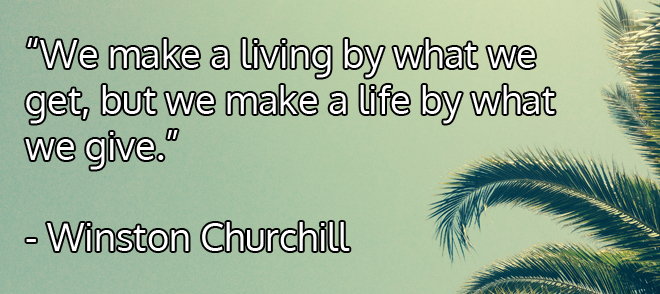
Sharing knowledge builds relationships
I've had a variety of coffees and hang-outs with local content-marketing types like myself where we've chatted about our various projects, struggles we're having, and how we can provide better service for our clients. I've received advice and doled it out in kind - but what's important in those interactions is that we've moved from being internet strangers to real-life acquaintances (in fact, if we're lucky maybe we can even level up to being friends, who knows?)
Everything in life is about who you know. This applies to both online and offline relationships, and if you position yourself as someone who isn't willing to take the time to help other people then it's very likely that, in turn, people won't take the time to help you.
Especially in this digital age, the more people you know and develop healthy, positive relationships with the better off you'll be. Gone are the days of lone-wolfing it and trying to alienate everyone for fear that they might use your knowledge against you; by surrounding yourself with a vibrant community and constantly working at growing your network by sharing what you know and helping one another you set yourself (and everyone you help!) up for future success.
Sharing knowledge can change the world
By working together and sharing ideas, information and experience we can make really great things happen.
Case in point: open source software. The PHP language, which powers about 60% of websites, or Wordpress, which powers about 30% are both, open-source. Huge, world-changing websites like Facebook wouldn't exist without open-source tools like PHP and MySQL. Linux, which is the open source code behind Android, powers most of the phones on the market today, and it's creator, Linus Tovald also created an open source tool called Git, which has changed the way that millions of developers work and build collaboratively.
Open source is my favourite example of the benefits of knowledge-sharing and collaboration because it hasn't resulted in mass unemployment or people losing their job prospects because they taught someone else what they knew. In fact, it's only strengthened the developer community and allowed them to make amazing things together.
Why does this matter?
It matters because the world is rapidly changing, and having a mindset of scarcity is something that, collectively, we're moving away from. People are starting to realize that there is in fact room for everyone to be successful, and by lifting each other up we all benefit from it.
I've seen it firsthand at events like the Winnipeg Game Jam, and at local events held by groups like RampUp Manitoba, Skullspace, New Media Manitoba and AssentWorks (to use a few local examples). By sharing knowledge and resources our communities are growing and flourishing, and by helping other people we become more powerful, ourselves. Giving away knowledge doesn't diminish how much of it you have, and we all benefit from a community of people (in whatever profession) who are willing to contribute and make that community the best that it can be.
Why you should share:
Know what the best part in all of this is? Helping people feels good. The feeling that you get when you do someone a favour, introduce them to someone who helps launch their career, or even give them a hand in navigating a sticky situation is so rewarding, and that person will remember you for what you did for them and will be more than willing to help you in the future.
Sure, there are exceptions to this rule -some people are just jerks- but going around assuming that everyone is trying to screw you over or waste your time is a pretty sad and lonely way to go through life, and pretty much guarantees that nobody will want to work with you once your true colours show through (and believe me, they always do).
The world is changing. Like I said at the beginning of this post: we live in an information economy, and knowledge is power - especially when you have a lot of it and share it readily. When you take the time to share what you know with people it guarantees that you will be successful in your endeavours because people will want to work with you and help you. It also guarantees that you will be more respected by your peers, more well-liked, and that you'll be a happier person overall because (and this is really the most important part, at the end of the day.)
What is the most important piece of knowledge that someone had given you? I'd love to know!
7 Steps to Grow Your Social Influence
- by Alyson Shane
Back in the days of yore (read: pre-social media times) most of what we did in our non-work hours stayed that way. Our professional and personal lives rarely mixed.
These days, those lines keeping parts of our lives separate have begun to blur, and we are constantly Tweeting, Snapchatting, posting, watching, sharing... you name it, we're likely doing it in one form or another online. While this means that we have the ability to be more social, it also has larger implications for how we are percieved by our peers, potential employers, and clients online as well.
Whether or not we would like to admit is, how we act online plays a big part in contributing to our professional reputations. People will judge based on the sum total of what you're shared online, and the internet never forgets - even if you delete what you've posted, it's still out there.
With that in mind, here are a few tricks that I've picked up to manage my activities online and to use my social media profiles to grow my influence:
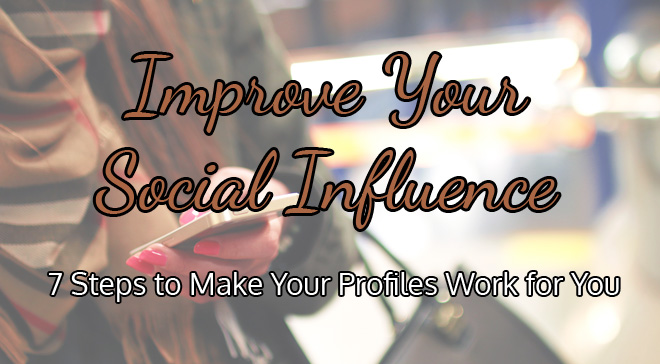
1. Create and Curate Your Profiles
Are the social platforms that you hang out on the ones that are most beneficial to you and your professional goals? It's likely that you're already on Facebook, Twitter, and LinkedIn, but if you're in the food, travel, fashion or lifestyle business, you should also have an active Instagram and Pinterest account, with relevant and up-to-date profiles on each.
The trick to using all of these platforms is to present yourself as someone interesting who knows how to use each of their social platforms in the best way possible. Edit your profiles to fit with your goals for each social platform and include links, if possible, as well as a well-taken photograph of yourself.
2. Share Your Content
Facebook, Twitter and Instagram operate essentially as "show and tell" platforms for content, so if you just knitted a great kitty sweater for your Etsy store or wrote a terrific blog post reviewing all the Air BnB locations in Thailand, share it and show your networks your skills.
In particular, content that educates, entertains, or encourages people will recieve a better reception than something which is self-serving or pitches a product. For example, if every other post is a plea for someone to buy your book, it's more likely that they will start ignoring you than your post will suddenly inspire them to log into Amazon.
3. Be Nice
In order for people to care about you, you have to care about them. Be genuinely interested in what others in your community or profession are doing, and don't hesitate to share their successes across your networks.When you are actively sharing and being interested in other people it will encourage them to do the same for you, because you are demonstrating not only that you're interested in them, but that you are willing to help them share their successes by showcasing or congratulating them on your network for everyone there to see. At the end of the day, people want to see nice people succeed, and the quickest way to success is to actively be nice to everyone you meet.
4. Be a Part of a Community
Social media is social first and media second. What I mean by this is make sure that you're using social media to build relationships, not just to broadcast your successes or thoughts.
For example, every Tuesday morning on the way in to work I participate in #blogchatca, a (you guessed it) Twitter conversation about blogging. I'm also a part of Kyla Roma's Daring Creative facebook group, and participate in the monthly #DaringCreative twitter chats she hosts as well. Being a part of these communities not only expands my network to people that I might not have otherwise been able to connect with, but also allows me to develop relationships with people over a shared interest and connection
5. Be Generous with Your Knowledge
One of the amazing things about digital communities is the amount of knowledge that has become available as a result of sharing online. I've found that in a lot of circles this has led to a "pay it forward" model of sharing information - that is, that openly giving and sharing your knowledge will pay off for you in the end.
Generously share news, knowledge, tips or other pieces of information that you think will help others achieve their goals. This not only helps others, but also works to build your social profile as someone who now only knows what they're talking about, but is confident enough in that knowledge to be willing to help others learn, as well.
6. Be Consistent
Being consistent means committing to a certain schedule of publishing and sharing content regardless of how you feel. We all have slumps and bad days (and hey, even I take a break from Twitter if my day is jam-packed) but what matters is that over the long-term you have a consistent presence online.
This not only means posting and sharing content, but also responding to people who contact you and having the discipline to do so in a way that is in line with your persona. Eg: don't use excessive offensive language, don't snap at or belittle people because you're having a bad day, etc.
Which brings me to my next point:
7. Keep Negative Thoughts Private
Venting online, "vaguebooking" or "vague-tweeting" (posting passive-aggressive stuff without stating who you are directing it at), etc is not okay. Don't do it.
If you've been online for any length of time you've probably engaged in this sort of behaviour before (it's okay, I have, too, once upon a time) but it's time to grow up and start behaving like adults online.
The reason behind it is this: you never know who is reading your content. You might think that your Facebook is friends-only, but how do you know that a friend-of-a-friend won't see an inside joke and take offense? Or that slanderous thing you Tweeted about a co-worker might be a little too specific, and you might find yourself out of a job. Better to be safe than sorry.
In addition to potentially landing you in hot water, having a negative online persona has long-lasting consequences: people will think of your negative, snarky comments before they think of a helpful link that you posted, so even if you're generally positive online a bad day or a slew of passive-aggressive comments can destroy the online reputation you've worked so hard at building.
There are a multitude of ways in which your bad attitude could backfire, so it's safest to keep it offline completely (or, focus on being more positive.)
These are just a few steps that you can take to start expanding your social reach and growing your influence online. Do you have any suggestions? I'd love to hear them!
5 Steps to a Business Blog
- by Alyson Shane
One of the best ways to make your business stand out online is by blogging regularly. It helps establish you as a thought leader in your industry, gives you a way to share things relevant to your audience or client base, provides valuable SEO content, and gives you tons of information to add to a newsletter (if you don't have one, see why you should here.)
However, for someone who has never blogged before it can be a daunting task to tackle head-on, which is why I've broken things down into five easy steps. Let's get started!

1. Define your blogging goals
Ask yourself: what do I expect to get out of blogging for my business? If you can't answer that question, take a look at a few common blogging goals below:
- Establish yourself as a thought leader in your industry. Ideally people will read your blog and see that you know what you're talking about, which in turn makes them trust your business.
- Create unique share-able content for social media. If all you do is share information about sales and products then people will stop paying attention pretty quickly, because people want to feel like you're doing more than just selling a product or service at them.
- Improve your Search Engine Optimization rankings. Instead of ranking for keywords relevant to your business. products or services, you can rank for the topics that your audience or customers are interested in as well.
The biggest thing to keep in mind when setting your blogging goals is how they align with the kind of content your audience and customers want to read. By posting interesting, relevant content you'll guarantee a growing group of dedicated readers.
2. Do your research
Before you hit 'publish' on your first post, take some time to see what your competitors are blogging about. The topics they discuss, their tone (formal or informal), and the style of posts (video, text-based, infographic, etc) give you a better understanding of what your audience expects, and if you should be blogging at all.
Once you've identified a few competitor'd blogs, spend some time looking into things like post frequency, which topics they discuss, who writes them, and how much engagement they receive.
3. Choose a blogging platform
The software you choose will depend on a variety of factors, such as how much time you want to spend setting up your blog, how customized you want it to be, how much functionality you want, and whether you want to integrate it into your existing website (spoiler alert: you do. Don't drive traffic away from your main website if you can help it!)
The best thing to do is to have your entire site hosted on a blogging platform such as WordPress, Tumblr, Medium, SquareSpace, or Blogger. With the exception of Medium you can change the design (or theme) for your blog to any of the offered themed, or you can tweak the existing templates, if you're savvy like that. This allows you to have all of your business' info in one place.
I would also recommend using your own domain name instead of the free URL generated by the platforms (eg: the WordPress site will read "www.yoursitehere.com" instead of "www.yoursitehere.wordpress.com." Paying for a domain is cheap (mine is $7/mth) and is incredibly more pforessional-looking, so if you're serious about your website and your blog, make sure that you buy a domain and point it to the hosted site.
The upside to hosted solutions is that you don't have to maintain the website itself, though it does limit your customization.
4. Decide which topics to cover
If you've spent some time defining your goals and doing your research, then you should have a pretty good idea as to what kinds of topics to cover for your business blog.
Still stuck? Follow these steps for some additional inspiration:
- Think broadly about your topics. Don't worry about specific post titles - think about the kinds of topics that would interest people involved in your industry. Eg: if you work in content marketing, write about topics like social media.
- Break these larger, broader ideas down into subcategories. For social media this could look like: link building, SEO tips, making the most of different social platforms, etc.
- Once you have these subcategories you can start doing research into keywords and popular topics. One of the best ways to do this is to use GoogleAdwords Keyword Planner, which will give you up to 800 related keyword phrases for each of your subcategories.
A word of warning: don't blog about things that you don't understand! If you think you want to blog about a particular topic, do your research first. Read extensively about your desired topics and then start writing.
5. Plan, plan, plan!
One of the most important steps is to plan out a posting schedule. An abandoned, empty blog is worse than no blog at all, so based on your competitor's blogs, figure out how often you should be posting new content (daily, weekly, etc) and if this is something that you can manage on your own. If not, consider getting an employee to handle researching and publishing your content for you, or hiring a ghostwriter who will write on your behalf.
Once you know who will be writing and how often, outline your blogging goals in a specific manner so you know what milestones you want to achieve and when. Some examples include 10,000 visitors per month, a 6% conversation rate from readers to customers, or to increase search visibility from 15 keywords to 75 keywords. Ultimately, these goals are up to you.
Make sure to also outline a process for coming up with topic ideas and turning those topics into written, edited and published content. You don't need to include exact dates and times per-se, but something like "publish a blog post every Friday" can be sufficient.
The process of creating this sort of content plan is called creating an Event Calendar, which is a key factor in making sure that you always have fresh, interesting content to post on your blog and share across social media.
You're done!
By this point you've thought about what sort of blog you need to have, how you're going to host it, what sorts of topics you're going to discuss, and who will be writing your content for you.
While these aren't always easy steps to implement, they are crucial to make sure to you start blogging the right way, and that your blog doesn't fizzle up and die after a few posts. By planning in advance and doing your research, and can make sure that your blog will bring you the results that you want for years to come.
Do you have any tips for starting a business blog? I'd love to hear them!
